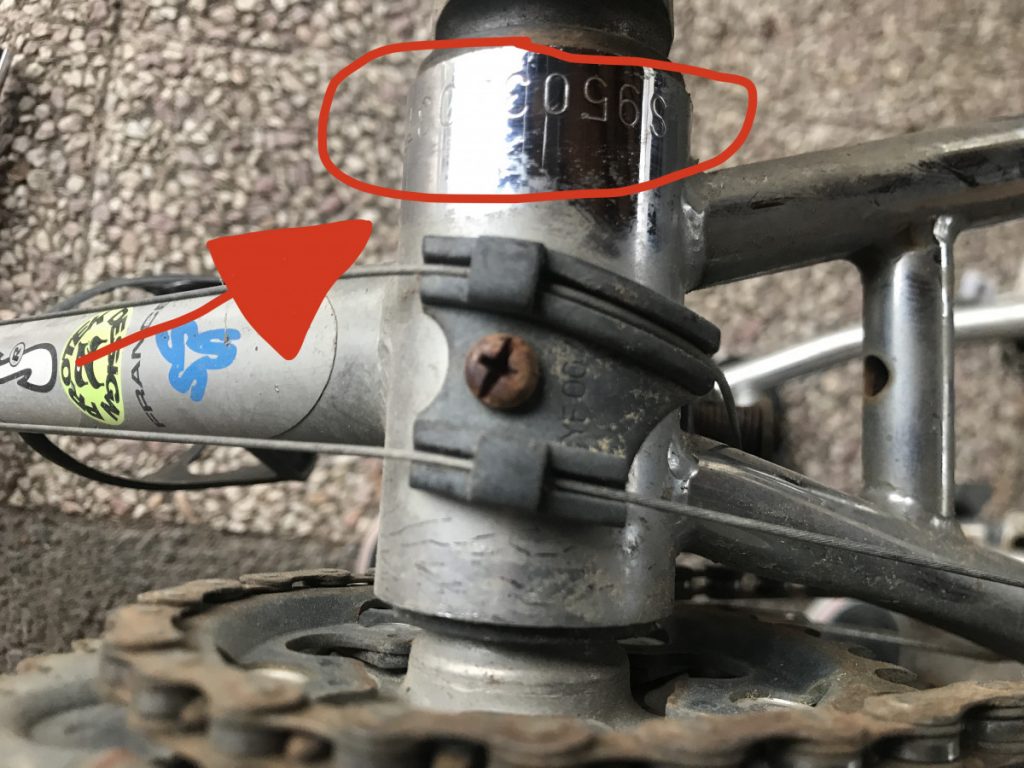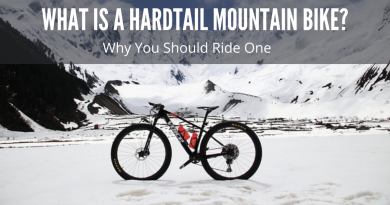How To Know If A Mountain Bike Is Stolen? (Easy Guide)
Each year more and more bikes are stolen worldwide.
Mountain bikes are much easier to strip for parts and resell than cars & motorbikes, making them a lucrative target for thieves and scammers who take advantage of unsuspecting buyers.
We show you how to tell if a mountain bike is stolen, and how to avoid buying a stolen bike.
- How to Tell If A Mountain Bike Is Stolen?
- 1. How Can I Check If A Bike Is Stolen?
- 2. Can The Seller Answer Questions About The Bike?
- 3. Is The Price A Little Too Good To Be True?
- 4. Are The Photos Generic?
- 5. Has the Bike Recently Been Repainted?
- 6. Will The Seller Speak On The Phone?
- 7. Is It The Same Bike as Advertised?
- 8. What Happens If You Buy A Stolen Bike?
- 9. Bike Scams To Be Aware Of
- Conclusion
How to Tell If A Mountain Bike Is Stolen?
One of the worst feelings is finding out that your beloved bike has been stolen. Even with insurance, it’s still a very unpleasant thing to go through.
No one wants to contribute to this, and no one wants to find that they have ended up buying a stolen bike. There are, however, certain steps that can be taken to ensure that you have not accidentally bought a stolen bike and thereby supported the industry.
1. How Can I Check If A Bike Is Stolen?
Check websites
There are a couple of websites that are very useful for doing this. Bikeregister.com and Bikeindex.org both feature a registry of bike serial numbers that allow you to check if the bike you are looking at buying has been stolen. It is also a very useful resource to use if your own bike has been stolen and you want people to look out for it.
Where To Find A Serial Number On A Mountain Bike?
It’s good to know where to find a bike’s serial number so that you can record your own as well as look for the serial number of the bike that you are buying. Serial numbers can usually be found below the bottom bracket where the pedal cranks meet. If you can’t find it check with the manufacturer as some brands like to hide the serial numbers.
It’s a simple matter to turn the bike upside down and check the number. If the seller doesn’t want to let you do this, or if the serial number has been damaged in some way to make it unreadable, then this should be an immediate red flag and a sign that the bike could be stolen.
Make a note of your own serial number as well, in case the worst happens and your own bike gets stolen. It will offer an invaluable method of tracking down the bike.

Search bike websites, forums, and social media
Often when people lose their pride and joy they post their stolen bikes all over bike websites, social media, and forums. Check websites like pinkbike.com, facebook.com, and forums for any stolen bikes in the same area.
2. Can The Seller Answer Questions About The Bike?
When looking at buying a second-hand bike you probably want to ask as many questions as possible anyway to make sure that everything has been recently serviced and is in good working condition. Asking questions can also give some insight into the seller and how much they know about the bike that they are selling.
Ask about the components
Most people who are selling bikes – in particular, high-end bikes – tend to know quite a lot about them. If you ask questions about the various components, such as any upgrades or parts which have been replaced. If the seller seems unsure or vague then this may be a sign that they don’t know a great deal about the bike – Which could mean it’s stolen (but not always).
Ask for receipts
If the bike is a few years old then there might be legitimate reasons for the seller to not have the receipts, but it’s worth asking all the same. The lack of receipts by itself is not proof that the bike is stolen, but if they do have the receipts then that is a good sign that everything is above board.
Ask when was the bike was last serviced?
Anybody that rides mountain bikes will know they need to service their bike, so ask: when were the brakes were bled? when was the suspension last serviced? When were the wheels last trued? etc. If they struggle to answer the questions then it could be a red flag.
Why are they selling?
Often people sell bikes because they are looking for a change, or they want to upgrade, or perhaps they want to switch disciplines (downhill to enduro, for example). Other times they might be selling because they are getting out of the sport.
There should always be a reason for the sale, however. If you surprise a seller by asking them why they are selling, a genuine seller will have an answer whereas someone selling a stolen bike will probably not have an answer ready to go. It is also fine to ask follow-up questions. If you are not satisfied with the answer then this could be a bad sign.
This can also be true in the description of the bike in the advert for it. If the advert is lacking in detail, or if it only includes the bike’s generic description from the manufacturer’s website, then this could be a sign that the seller doesn’t actually have any real knowledge of the bike.
A quick Google search can find what the manufacturer says about the bike, and this can then be compared with the seller’s description.
3. Is The Price A Little Too Good To Be True?
Everybody loves a bargain and there are some great ones to be had when looking for a second-hand bike. Perhaps the seller just wants a quick sale, for example. However, as a general rule of thumb, if a price seems to be just that little bit too good to be true then there is a good chance that it is.
Check what similar bikes are selling for: Sites like Pinkbike can give a good idea of what kind of prices people are selling similar bikes for. eBay can also give a good idea of what they are actually selling for. If the price is much lower than the rest of the current market then you will need to find out why.
4. Are The Photos Generic?

Are the photos that have been used in the advert original photos of the actual bike that is being sold or are they taken from elsewhere – in particular, from the manufacturer’s website. A quick reverse image search on Google can help to find if they are images that have been taken from somewhere else, rather than having been shot by the seller. Simply put, if the bike has a clean white background then it was unlikely taken by someone selling a second-hand bike.
Ask for particular photos: You can ask for a particular shot – for example, ask the seller to get a photo that includes the bike and some other feature, such as them giving a thumbs up in the shot, to ensure that they actually have the bike right there with them, rather than just pulling photos off the internet.
Focus on components: Another way to use this method to check the bike is to ask for photos of particular components. It will be a less obvious method of ensuring that they have the bike with them and it also has the added bonus of allowing you to check out some of the components up close.
5. Has the Bike Recently Been Repainted?
It is not unheard of for people to get custom paint jobs for their bikes. However, it is far from the norm and so it is worth keeping an eye out for bikes that have recently been resprayed. It could be a way to try and disguise a stolen bike.
Does the paint job look cheap? If people are going to get a custom paint job for their bike they are usually doing it to make their bike look as good as possible. If a paint job looks badly done then this is a sign that it is being used to disguise the bike. A bad paint job is fairly easy to spot.
6. Will The Seller Speak On The Phone?
If the seller is evasive and refuses to speak on the phone, trying to communicate solely via email, then they might have something to hide. They might want to avoid asking questions. It’s worth trying to insist on speaking to them on the phone, and if they refuse then simply walk away.
7. Is It The Same Bike as Advertised?
So, you’ve arranged to meet the seller. They show up with the bike, and something doesn’t look quite right. Make sure that what they are selling is the exact same bike as advertised – the same components, the same frame, and the same colour.
If anything has been changed then ask the seller to explain the change. Changes such as this are a good way of seeing that the seller is not trustworthy, and possibly even that they have a number of different, stolen, bikes that they are trying to offload.
Even if it is not stolen then it could be a sign that they are trying to add lower-value parts to the bike they are selling in order to get rid of them.
8. What Happens If You Buy A Stolen Bike?
If the worst comes to the worst and you find that you have bought a stolen bike then legally you have to return it to the seller if they come looking for it. Legally the bike still belongs to the original owner and if they can prove that it is theirs then there is nothing that you can do. Always ask to get the seller to sign a contract of sale when you buy the bike, and ask to see their Id if you are at all nervous. We have a bike-specific contact of sale you can print off here.
If the police stop you with a bike that they suspect is stolen they can impound it as evidence. You could also, potentially, be charged with handling stolen goods. You could even be charged with theft if you can’t prove that you bought it from someone else.
The law will be on the side of the person who had their bike is stolen, which is why it isn’t really worth taking the risk even if you think you have found an amazing bargain.
It’s still a good idea to look out for genuine bargains, but go into any negotiations fully prepared and look out for any warning signs!
9. Bike Scams To Be Aware Of
Fake websites
There are many fake websites out there, and some can be very tempting with the promise of a new bike at half of the recommended retail price. Remember to check if the website site has a phone number and an address. Also, ensure they accept a secure form of payment like Paypal, etc. If you are unsure, give them a call and ask lots of questions. It can also be worth searching for the website name on a search engine, sometimes other people might have posted about the site to warn others.
Read description carefully
There is a scam where criminals would post a picture of a toy replica, or take a photo of the box, and then make the description misleading so you think you are buying the full bike. So always read fully the description, and if you are not sure don’t buy.
Shipping number bike scam
There is a bike scam where a criminal lists a bike for sale online and the listing says shipping only, no collect available. Then someone buys the bike, and the criminal sends an empty box with a tracking number. Once the buyer receives the empty box it can often be hard to prove the box was originally empty and the criminal has the tracking to prove they sent something. If you are unsure, call the seller and ask where are from? and pretend you live close by, and say can you collect. If they refuse to give you a phone number or refuse to let you collect in person then this is likely a red flag.
Conclusion
Whenever you buy a secondhand bike you should always do your own due diligence, if you are unsure about anything it’s always better to walk away before you buy the bike. Whenever you do buy a bike, both fill in details and sign a contract of sale. However, if you suspect you accidentally bought a stolen bike then you need to check the first step of this post.




